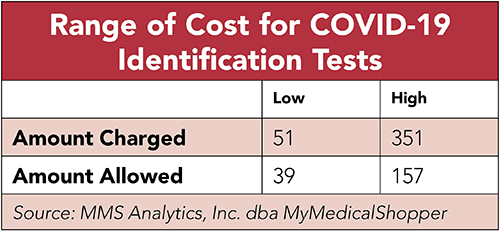 The price tag for COVID-19 tests can vary by hundreds of dollars, according to an analysis of medical claims by MMS Analytics in Portsmouth.
The price tag for COVID-19 tests can vary by hundreds of dollars, according to an analysis of medical claims by MMS Analytics in Portsmouth.
MMS found that charges ranged from $51 to $351 and allowed amounts (what was actually paid) ranged from $39 to $157.
Mark Galvin, MMS co-founder and CEO, says when people are scared in an emergency situation, they are unlikely to worry about how much a test costs, but it is another example of the lack of price transparency in the health care industry as well as the lack of awareness among patients. Galvin says it is common with medical tests and procedures to see the highest-priced option be five to 20 times the amount of the lowest-priced, even when accounting for the insurance-negotiated discount.
Galvin says the consequence of this price variation could mean billions of dollars in waste. He says it is often possible to find a higher quality, lower cost provider for just about every medical service, test or procedure close to home.
 A desire for transparency motivated Galvin to launch MMS and the MyMedicalShopper platform in 2014. Targeted mainly at employers who want to work with their employees to contain health care costs, the site provides cost and quality data for tests and procedures.
A desire for transparency motivated Galvin to launch MMS and the MyMedicalShopper platform in 2014. Targeted mainly at employers who want to work with their employees to contain health care costs, the site provides cost and quality data for tests and procedures.
“Our company has been working diligently to solve this problem,” says Galvin. “To give consumers the tools necessary so that they can know exactly how much something is going to cost both for themselves and their employer.”
This is not about changing providers or finding a new doctor, he says, as fees for doctor visits tend to be consistent. “But if your doctor says he wants you to get a COVID-19 test, you can look on the website and decide where to go,” says Galvin. “In this particular example, you’re looking at a 400% disparity in the actual cost of that test, depending on where you end up going.”
These disparities are more important than ever, he says, as people are paying higher co-pays and deductibles. He adds that the more people care about price, the more the insurance industry will have to adjust. “Healthcare doesn’t have market-driven competition because the third-party payer system has taken the consumer out of it. As people start to care about the costs, you create an army of good consumers,” Galvin says.
For more information, visit MyMedicalShopper.com.

 Current Issue - April 2024
Current Issue - April 2024